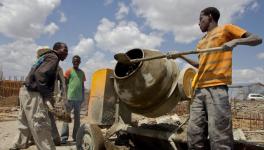NATO Returns to Libya to Challenge Russia
Libyan conflict set to intensify as NATO plans to intervene.
The great game in Libya has begun surging with the United States shedding its strategic ambivalence and resorting to a proactive role. Earlier this week, the Pentagon marked a dramatic escalation by accusing Moscow of bolstering Kremlin-linked mercenaries who are allegedly helpingKhalifa Haftar, the eastern warlord in Libya.
In an extraordinarystatementon May 26, the US Africa Command (AFRICOM) said that jets were flown last week from Russia to eastern Libya to a base controlled by Haftar in the wake of his offensive to capture power in Tripoli suffering a major reverse recently due Turkey’s military help to the UN-backed Libyan Government of National Accord.
The AFRICOM claimed that the Russian jets are “likely to provide close air support and offensive fires” for Russian mercenaries working for Haftar — the Wagner Group, a shadowy private army that western experts link to Yevgeniy Prigozhin, a close ally of Russian President Vladimir Putin.
“Russia is clearly trying to tip the scales in its favor in Libya,” said AFRICOM commander in the statement. “Just like I saw them doing in Syria, they are expanding their military footprint in Africa using government-supported mercenary groups like Wagner.” He added: “For too long, Russia has denied the full extent of its involvement in the ongoing Libyan conflict. Well, there is no denying it now.”
The AFRICOM has since published additional details andsatellite imagesacross its social network channels. It says, “Over multiple days in May, Russian MiG 29s and SU-24 fighters departed Russia. At that time, all the aircraft had Russian Federation Air Force markings. After they land at Khmeimin Air Base in Syria, the MiG 29s are repainted and emerge with no national markings. They are flown by Russian military members & escorted by Russian fighters based in Syria to Libya, landing in Eastern Libya near Tobruk for fuel. At least 14 newly unmarked Russian aircraft are then delivered to Al Jufra Air Base in Libya.”
Oil-rich Libya is in the grip of its worst bloodshed since the ouster of Moammar Gadhafi during the 2011 NATO intervention. The war that followed is being fuelled byregional and European powers, which have backed the warring sides for a variety of interests. But Washington has pointedly singled out Russia for its verbal fusillade.
Indeed, there has been a steady build-up leading to this point. On May 7, the US State Department officials raised the ante by holding a special briefing on‘Russian Engagement in the Middle East’with focus on accusing Russia of worsening the situation in Libya by funnelling Syrian mercenaries.
This briefing came a day after a confidential UN report on Libya sanctions said the Wagner Group has “acted as an effective force multiplier” for Haftar’s command, which has led to a “significant escalation” of the conflict and “a worsening of the humanitarian situation in Libya.”
Seizing upon the UN report, Chris Robinson, a State Department official who focuses on Russia, told reporters that the Wagner Group is “often misleadingly referred to as a Russian private security company, but in fact it’s an instrument of the Russian government which the Kremlin uses as a low-cost and low-risk instrument to advance its goals.” He claimed that the “very heavy and advanced weapons” the Wagner Group wields in Libya indicate it is not a private company.
Jim Jeffrey, the US special envoy for Syria, who took part in the briefing told reporters that Washington believes Russia is working with Syrian President Bashar al-Assad to transfer militia fighters and equipment to Libya. “We know that, certainly, the Russians are working with Assad to transfer militia fighters, possibly [a] third country, possibly Syrian, to Libya, as well as equipment.”
In essence, the senior US diplomats kickstarted a new US policy trajectory. This became clear when on May 14 when in an interview with the Italian La Repubblica, NATO Secretary-General Jens Stoltenbergdisclosedthat the alliance is ready to support the official Tripoli government.
As he put it, “There is an arms embargo in Libya to which all parties must abide. This does not mean putting the UN-recognised Fayez al-Sarraj government (in Tripoli) and Haftar into the same equation. Therefore, NATO is ready to support the Tripoli government.”
No sooner than Stoltenberg’s interview appeared, Turkish President Recep Erdogan telephoned him to discuss Libya. According to aNATO readout, Stoltenberg told Erdogan,
“NATO is prepared to help Libya in the area of defence and security institution building, in response to the request by the Prime Minister of the Government of National Accord to assist the GNA to strengthen its security institutions. Any NATO assistance to Libya would take account of political and security conditions, and would be provided in full complementarity and in close coordination with other international efforts, including those of the UN and the EU.”
Two days later, on May 16, Stoltenberg already held aphone conversationwith thePrime Minister of Libya, Fayez al-Sarraj.Stoltenberg is not a free agent. The NATO takes its cue from Washington. Clearly, Washington is inserting NATO into the Libyan conflict as a new strategy. Of course, any such NATO intervention in Libya also implies that the western alliance is moving into Africa.
In the western assessment, any Russian consolidation in Libya would weaken NATO’s dominance of the Mediterranean.On May 26, the commander of US air forces in Europe and Africa said that if Russia obtains permanent coastal bases in Libya, its “next logical step” will be to introduce long-range air defence systems, which could pose threat to NATO’s access to its southern flank.
There are incipient signs that the UAE, which has been a key provider of weaponry and funds to Haftar is having a rethink, presumably due to pressure from Washington, whose game plan is to isolate Russia.But this can be a tactical shift, considering the acuteness of the UAE-Turkey rivalries currently.
Egypt, another supporter of Haftar, continue tosupport Hifterpolitically, diplomatically,logistically and security-wise against terrorist groups in Libya. while Egypt will not intervene militarily in Libya, strong coordination continues between the Egyptian leadership and Haftar on one side and between Cairo and Moscow on the other.
Cairo appears to estimate that Hifter’s recent withdrawals from thefrontlineis atactical move to protect the remainingmilitary equipment and weapons that were not destroyed in Turkey’s airstrikes.
To be sure, the NATO intervention in Libya cannot be to Russia’s liking. Russia has strong political and economic interests in Libya. The Pentagon accusation regarding Russian jets to Libya suggests that Moscow is stepping up too.
The US (and NATO) strategy will be to evict Russia from the eastern Mediterranean, including from its bases in Syria. Unsurprisingly, Washington and Ankara are cozying up to each other lately. The NATO’s intervention in Libya is heartily welcomed by Turkey.
Suffice to say, the US and Turkey find themselves today on the same side over Libya. Russia, therefore, has reasons to be anxious about the future of its relations with Turkey and its overall standing in Syria. Interestingly, Russia and Syria held a joint exercise last week to strengthen the security of the naval base in Tartus on the eastern Mediterranean.
All in all, the US moves over Syria only underscore that Washington’s containment strategy against Moscow continues to be in full cry, notwithstanding the rising US-China tensions.Russia’s introduction of fourth-generation fighter aircraft in Libya suggests that Moscow will push back at NATO’s intervention.
The gathering storms over Libya prompted the French Foreign Minister Jean-Yves le Drian to raise the warning on May 27 while addressing at a French Senate panel, “The crisis is deepening. We are facing a ‘Syrianization’ of Libya.”
One major objective of the NATO in Libya will be to curb the refugee flow into Europe. Put differently, the European Union becomes a stakeholder in the US strategy to insert NATO into Libya. This will significantly dampen the prospects for any rapprochement between Moscow and the West in a conceivable future.
On the other hand, the transatlantic partnership that has been showing wear and tear lately, gets a much-needed fillip, which of course will be to the US’ advantage and would have wider ramifications. The Trump administration has mooted the idea of hosting a G-7 summit in the US next month to pick all the low-hanging fruit. Libya will be one of them.
Get the latest reports & analysis with people's perspective on Protests, movements & deep analytical videos, discussions of the current affairs in your Telegram app. Subscribe to NewsClick's Telegram channel & get Real-Time updates on stories, as they get published on our website.
























